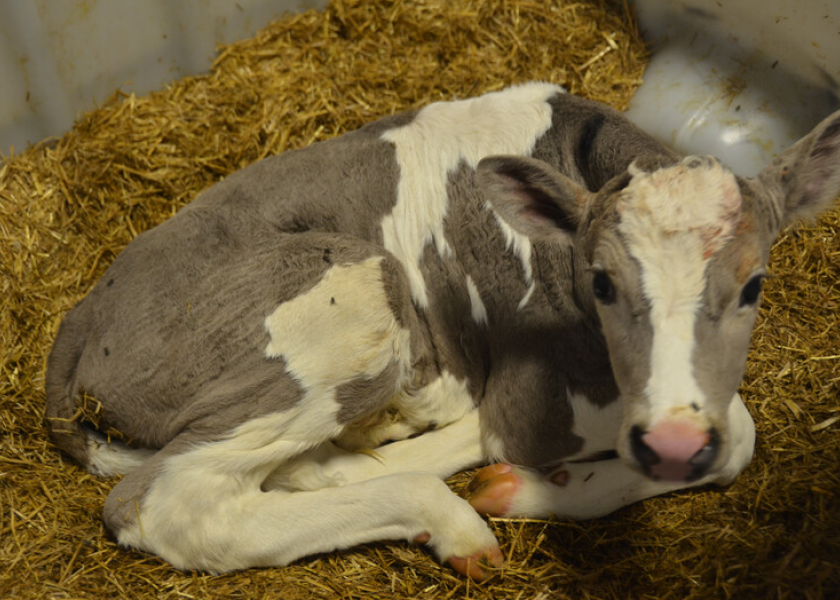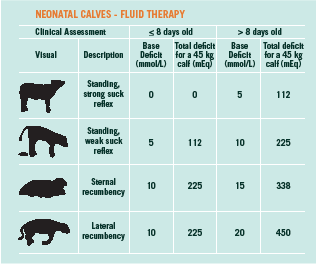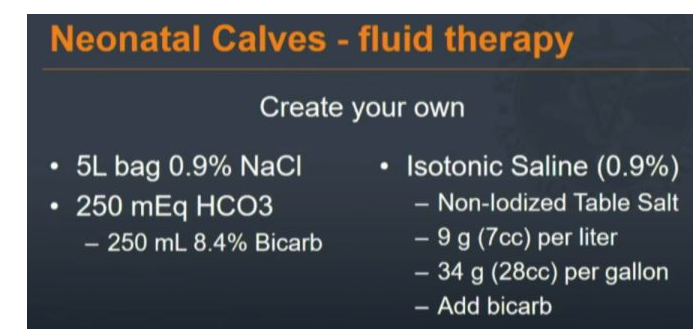Practical Fluid Therapy Options For Neonatal Calves

Neonatal calves often benefit from fluid therapy on the farm. In most scenarios, Andrea Lear says she chooses either oral or intravenous (IV) therapy, with the decision based on the animal’s age, degree of dehydration present as well as what she determines from her clinical assessment.
She usually starts the clinical assessment by calculating the percentage of dehydration, the base deficit, that is present.
“While you can use skin turgor, it’s more subjective; the most accurate and objective method is eyeball recession,” says Lear, DVM, DACVIM, MS, PhD, assistant professor, Large Animal Clinical Sciences, University of Tennessee.
The percentage of dehydration can be quantified by looking at eyeball recession at the medial campus in millimeters, and then times that by two. The formula is simply % Dehydration = Eyeball Recession (mm) x 2%/mm.
“For instance, if a calf is 4 millimeters recessed at the medial canthus times by two, that equals 8% dehydration,” she says.
Along with dehydration, Lear says acidosis, with central nervous system (CNS) depression, is a common issue in neonatal calves. Correlating problems may include poor suckle, shock, hypoglycemia and D-lactic acidosis.
“We need to be concerned about D-lactic acidosis and consider shock; plus going off feed for just 12 hours is enough to cause these animals to be hypoglycemic, especially if they're suffering from bacteremia or sepsis,” she says.
Calves with a hydration status of less than 8% dehydrated and relatively normal mentation can be treated with oral fluid therapy. However, if severe dehydration is present – generally above 8% – then you likely need to provide IV therapy.
Regardless of which fluid therapy you ultimately choose, keep in mind the neonatal calf contains more body water than an adult. “Their interstitial compartment is much more spongy and more likely to hold water,” she says. “Why that matters to us as practitioners is that they are much more likely to be over-fluid resuscitated, so we can actually drown them.”
Lear says the Fluid Therapy Chart provides a good reference for what fluid administration is needed to resuscitate the calf, from a base deficit to a total deficit. The recommendations are separated by age—calves less than 8 days of age versus over 8 days of age. In each scenario, the calf weighs 45 kg.
Lear spoke on the topic of fluid therapy in neonatal calves during the 2020 American Association of Bovine Practitioners Annual Conference, focusing on oral, subcutaneous and intravenous options.
Oral Fluid Therapy
“A calf that’s in the top half of the chart, we tend to go with oral electrolyte resuscitation and alternate with milk or a meal,” she says. “We do not want to remove milk feeding from our calves if possible, or at least for no more than 12 to 24 hours, because that gut needs to heal and they need the energy source.”
There are several commercial electrolytes available, and Lear recommends picking one with fair amount of sodium, potassium and chloride.
“We want between 90 to 130 milli equivalents of sodium in those solutions to make sure that we're resuscitating with enough sodium, which is commonly lost in diuretic calves,” she explains. “We also have to have some sort of alkalinizing agent in there, such as bicarbonate, acetate or propionate.”
Two benefits of acetate and propionate are that they can help with sodium absorption within the GI system, and they don’t affect abomasal pH, she notes.
Intravenous (IV) Fluid Therapy
This option is usually the best fit for severe dehydration. Positives of this option are it gives the practitioner control over what and how much fluid is administered; the main downside is expense.
With an IV, Lear says she generally gives between a quarter to half of the base deficit in a time period of between three and six hours.
“So, for instance, if I have a calf that's over 8 days of age, or laterally recumbent, and our base deficit is 450, I'm going to give them 100 to 225 mil equivalents over the first two to six hours of IV resuscitation,” she notes. “That should allow the calf to stand up, do what it needs to do, and then you can put it on an oral resuscitation solution.”
She recommends using bicarbonate to improve blood pH. Acetated ringers and lactated ringers are her second and third choices, respectively.
Many alkaline solutions are commercially available, but you can also create your own solution cost-effectively as indicated here.
Subcutaneous Fluid Therapy
A positive of this therapy, Lear says, is that it is a producer friendly method for resuscitation. A downside, however, is the fluid takes between 1 and 2 hours usually to be absorbed and you can use only isotonic fluids. For those reasons, she usually steers away from using this therapy option.
In some scenarios, Lear says veterinarians may find it difficult to use fluid therapy of any kind. In that scenario, she says consider using an IV bolus of 100 milligrams per kilogram of dextrose along with hypertonic bicarbonate bolus at one time. “That gets some energy into them and resuscitates them, and then you can switch them over to oral resuscitation.”
High-Protein Starter Improves Dairy Calf Weight Gain, Reduces Slumps At Weaning









